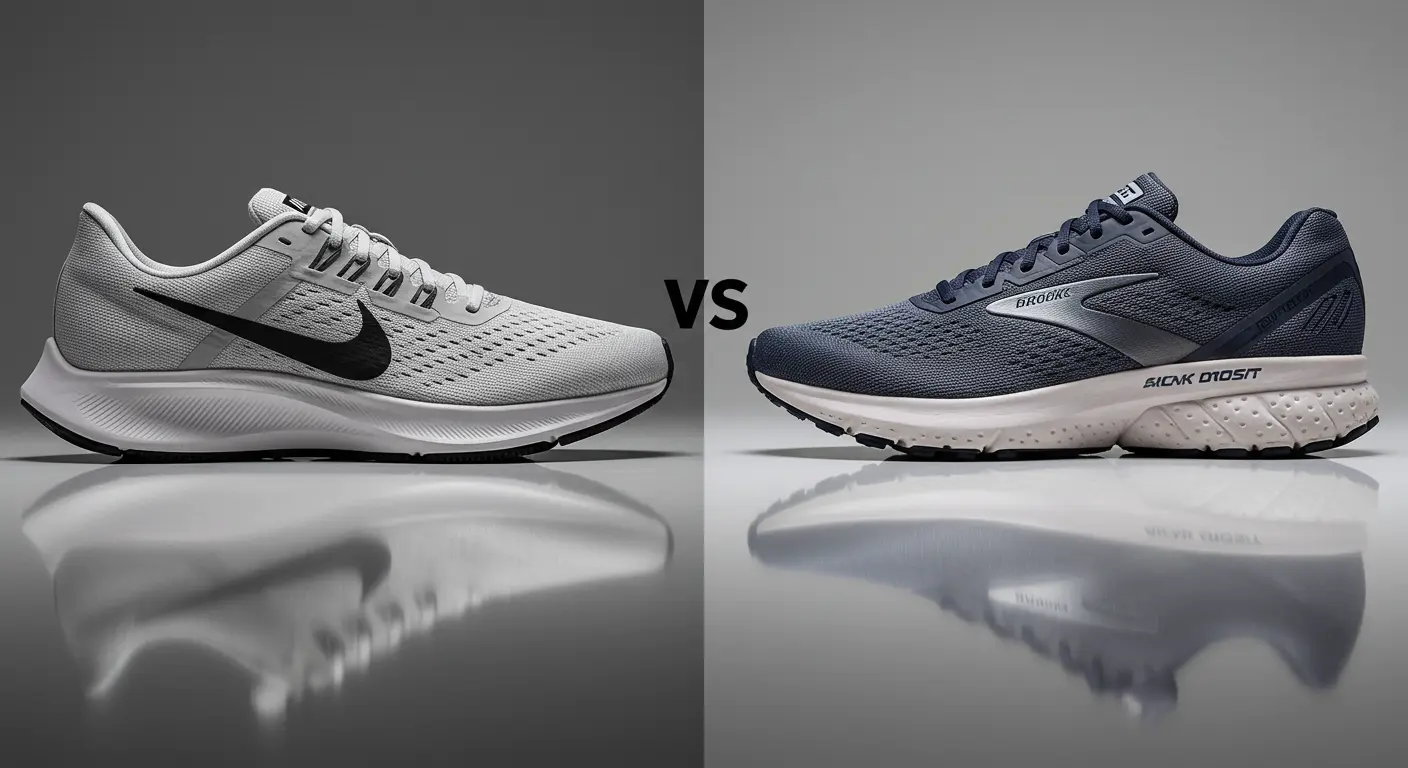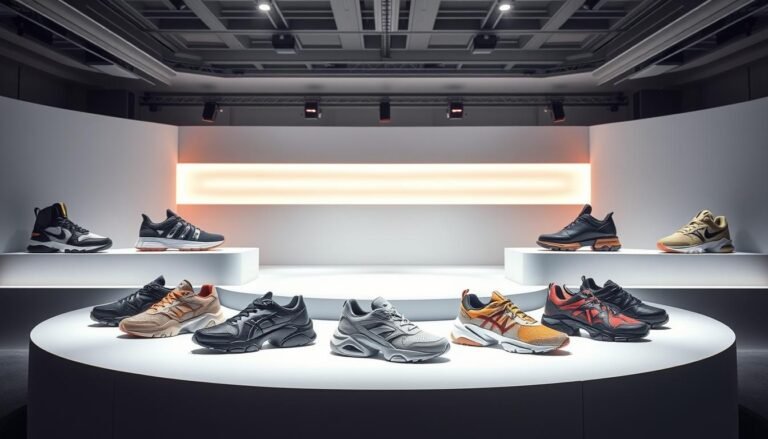Nike vs Brooks Running Shoes: Which Fits Your Running Style? (2025 Guide)
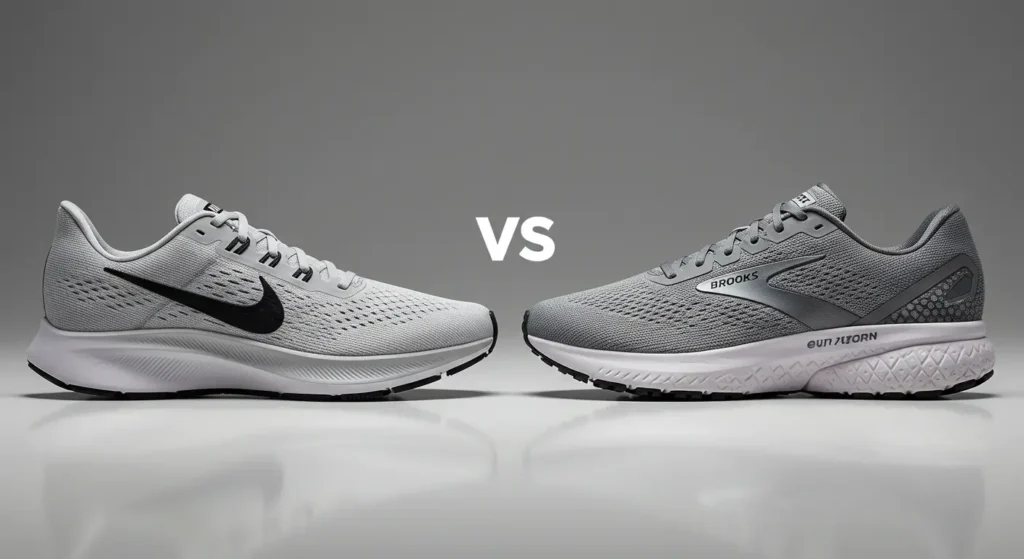
When it comes to brooks vs nike, the numbers might surprise you. In a recent survey of the WeeViews community, Brooks edges out Nike with 39.1% of runners wearing them, compared to 28.1% for Nike . This rivalry between two running shoe giants continues to shape the preferences of runners worldwide.
The battle becomes particularly interesting when comparing their flagship models: the Brooks Ghost vs Nike Pegasus. The Nike Pegasus stands as one of the most popular running shoes of all time , while the Brooks Ghost is known for its plush interior and balanced ride . Whether you’re examining weight differences (Ghost 17 at 10.1 oz men’s vs Pegasus 41 at 10.4 oz men’s) or their ability to handle marathon distances , both shoes offer compelling features for different running styles.
These brands represent two distinct philosophies in the running world. Nike shines with speed-focused tech like Zoom Air and Flyknit, bold designs, and a premium edge, while Brooks delivers plush cushioning with DNA Loft and BioMoGo DNA . For beginners especially, Brooks makes many of the best running shoes, with the Ghost and Glycerin lines being dependable options .
We’ve created this comprehensive guide to help you navigate the Brooks vs Nike running shoes debate.
By analyzing everything from cushioning systems to fit preferences, we’ll help you determine which brand aligns better with your running style, goals, and comfort needs.
Let’s dive into what makes each brand unique and how to choose the perfect shoe for your running journey.
Comparing Brooks and Nike Running Shoes
Table of Contents
Nike vs Brooks: Brand Philosophy and Design Approach
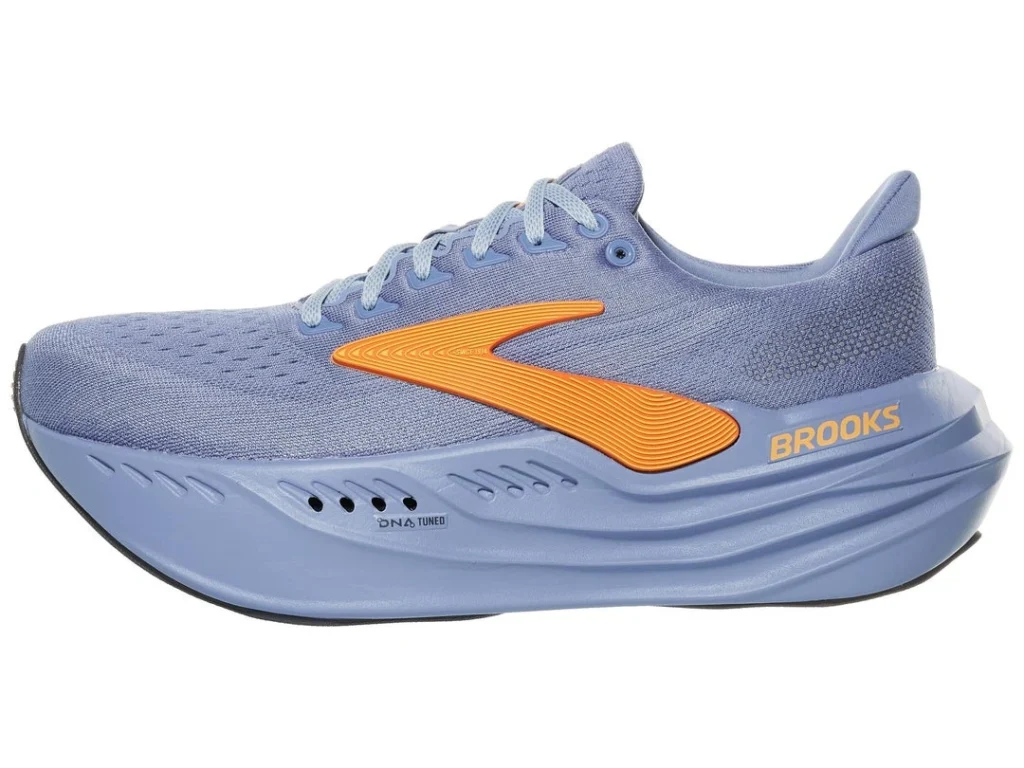
Image Source: Running Warehouse
The fundamental difference between Brooks vs Nike lies in their core philosophies and design approaches.
These foundational beliefs influence everything from shoe technology to marketing strategies and target audiences.
Nike: Innovation and Speed-Focused Design
Nike has spent over 50 years pushing innovation boundaries to inspire athletes of all levels [1].
At the heart of Nike’s design philosophy is what they call their “system of speed” — a proprietary combination of ZoomX foam and carbon fiber Flyplates that enhances runners’ performance [1].
This performance-first mentality has made Nike the dominant force in elite running for years.
The brand’s relentless pursuit of cutting-edge technology is evident in their racing footwear lineup.
For instance, their Vaporfly 4 features an updated Flyplate curvature designed to unlock leverage from the foot and ankle, alongside ZoomX foam — Nike’s lightest and most resilient midsole compound [1].
This focus on measurable performance gains has led to Nike shoes being worn by many of the highest-paid athletes in the world [2].
Brooks: Comfort-First and Runner-Centric Engineering
In stark contrast, Brooks entered the new millennium with a singular focus: running [3].
Unlike Nike’s multi-sport approach, Brooks exclusively designs running shoes, allowing them to concentrate their technology, research, and development entirely on runners’ needs [1].
Their philosophy embraces the individuality inherent in each runner’s stride rather than trying to correct it.
Brooks’ approach is rooted in science-driven development using feedback from real runners.
Their GuideRails technology exemplifies this philosophy — specialized plates that allow runners’ hips, knees, and joints to move through their own unique motion paths, only intervening when necessary [3].
Additionally, their proprietary DNA cushioning technology adapts to provide personalized cushioning based on how each foot strikes the ground [1].
Target Audience: Performance vs Everyday Runners
Nike has historically dominated the elite running space but struggles to connect with everyday runners, as admitted by their CEO John Donahoe [2].
Their “Consumer Direct Offense” strategy, which emphasized direct sales, initially paid off but has since created challenges in reaching recreational runners [2].
Meanwhile, Brooks has focused squarely on everyday runners. In 2022, Brooks ranked No.
1 in the US adult performance-running footwear market with a 22% share [4].
Their CEO Jim Weber believes Brooks can reach $4 billion in sales without artistic collaborations or hype drops that characterize Nike’s marketing [4].
The fundamental difference in approach is perhaps best summarized by Sean Rivers, a Portland running retailer, who noted: “In running specialty, Nike’s not the boss.
Brooks and Hoka are running the show” [2].
Moreover, Brooks’ strategy of selling through specialty running stores rather than focusing exclusively on direct sales has allowed them to maintain a presence “in every community from Des Moines to Spokane” [4].
Brooks Ghost vs Nike Pegasus: Flagship Model Face-Off
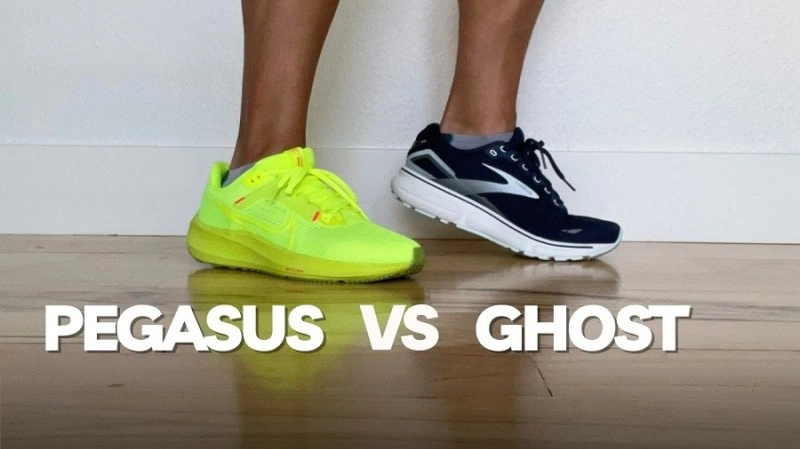
Image Source: RunToTheFinish
In examining the Brooks Ghost vs Nike Pegasus lineup, both flagship models reveal distinctive technical attributes that appeal to different running preferences.
These popular models showcase each brand’s unique approach to creating versatile daily trainers.
Cushioning Systems: DNA Loft v3 vs ReactX + Zoom Air
Fundamentally, the cushioning technologies diverge significantly.
The Brooks Ghost 17 utilizes DNA Loft v3 foam with added nitrogen in the forefoot (3mm) and heel (1mm) for enhanced cushioning and responsiveness [5].
Conversely, the Nike Pegasus 41 features new softer formula ReactX midsole foam that Nike claims is “13% more responsive than previous React technology” [6], alongside dual Air Zoom units positioned in both the forefoot and heel [6].
Heel Drop and Stack Height: 10mm vs 10mm
Regarding stack heights, the Nike Pegasus 41 measures 37mm in the heel and 27mm in the forefoot [6], maintaining a 10mm drop.
The Brooks Ghost 17 now features a 36mm stack height [5] with a reduced 10mm heel-to-toe drop—down from the previous 12mm in earlier models [5].
This adjustment potentially benefits runners prone to knee pain or IT Band issues [1].
Weight and Responsiveness: 10.1 oz vs 10.4 oz
Interestingly, despite its plush feel, the Brooks Ghost 17 weighs slightly less at 10.1 oz (men’s) [1] compared to the Nike Pegasus 41 at 10.4 oz (men’s) [5].
The Pegasus, although heavier, delivers a firmer ride suited for tempo runs, whereas the Ghost provides softer cushioning better suited for long runs [2].
Outsole Durability: Blown Rubber vs Carbon Rubber
As for durability, distinct outsole materials create different performance profiles.
Brooks Ghost employs soft blown rubber in the forefoot with multiple flex grooves for natural movement, while using harder carbon rubber in the heel for durability [2].
The Pegasus opts for a thicker, harder carbon rubber throughout, offering superior longevity [2] though showing potential wear concerns within 60 miles of use [6].
Upper Comfort: Jacquard Mesh vs Engineered Mesh
Finally, the upper constructions reflect each brand’s comfort priorities.
The Brooks Ghost features a “supremely comfortable” jacquard air mesh that feels soft against the foot [2].
The Nike Pegasus 41 uses an engineered sandwich mesh [2] with good breathability [6] and a Dynamic Midfoot Fit system for enhanced support [6].
Both models excel as versatile daily trainers capable of handling marathon distances [2], yet their technical differences create distinct running experiences that cater to different preferences within the Nike vs Brooks running shoes spectrum.
? Fit and Sizing: Which Brand Offers a Better
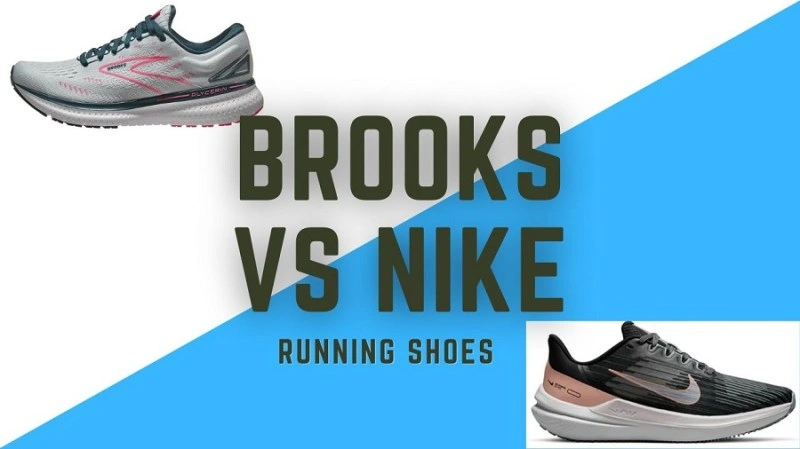
Image Source: RunToTheFinish
Proper fit can make or break your running experience, and the sizing approaches of Brooks vs Nike reveal significant differences that runners should consider.
Finding the right fit is essential for comfort, injury prevention, and optimal performance during your runs.
Nike Fit: Narrower Toe Box, Size Up Recommended
Nike running shoes are notorious for running narrow and small, particularly through the midfoot and heel [7].
The toe box is noticeably narrower, especially when compared directly to Brooks models [7].
This creates a snugger fit even in standard with options.
Furthermore, Nike doesn’t offer the variety of widths that you’ll find with other brands [1].
If you’re set on Nike shoes, most experienced runners recommend sizing up by half a size for a comfortable fit [8].
Brooks Fit: True to Size with Wide Options
In contrast, Brooks running shoes feature a wider toe box to accommodate natural foot splay when running [7].
This design makes Brooks an excellent choice for runners with wide feet, bunions, or a more squared forefoot [7].
Despite this roomier toe box, Brooks sometimes recommends going up half a size to a full size from your casual or dress shoes [9][10].
Additionally, Brooks offers generous width options in most popular models, including Narrow (B for men, 2A for women), Medium (D for men, B for women), Wide (2E for men, D for women), and Extra Wide (4E for men, 2E for women) [11].
Foot Shape Considerations: Narrow vs Wide Feet
Your foot shape should ultimately guide your brand choice.
If you have narrow feet or experience sliding side-to-side in shoes, Nike’s naturally narrower last might provide a more secure fit [12].
Alternatively, if your toes feel bunched together or you develop blisters on the outside edges of your feet, Brooks’ wider toe box could resolve these issues [13].
For those with wide feet, Brooks offers their popular models like the Ghost and Adrenaline GTS in multiple width options [7].
Beyond standard sizing, Brooks introduced two distinct fits: their Classic Fit, which hugs your foot while blending flexibility and structure, and their StealthFit, which provides a sleeker, closer-to-foot feel [14].
The fundamental rule remains: pay attention to how your feet feel rather than the size on the tag [4].
Your comfort should guide your decision between Nike vs Brooks running shoes.
Performance by Use Case: Daily Runs, Speed Work, and Trails
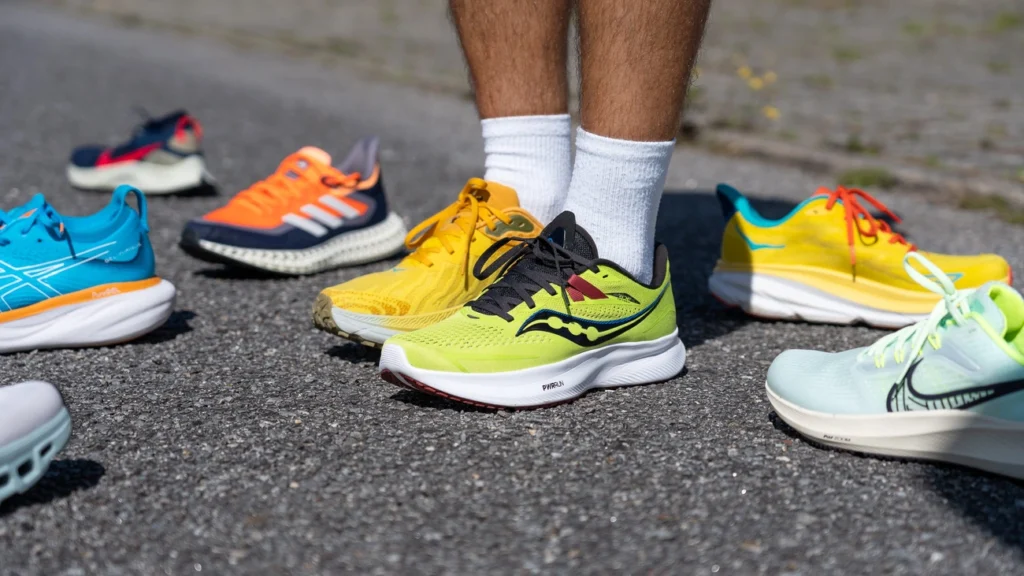
Image Source: RunRepeat
Choosing between Brooks vs Nike ultimately comes down to how each performs in your specific running scenarios.
Both brands offer specialized options for various running activities with distinct performance characteristics.
Daily Training: Ghost 17 vs Pegasus 41
Both the Ghost 17 and Pegasus 41 excel as versatile daily trainers.
The Ghost 17 provides a softer ride, making it ideal for long runs, yet still capable of handling occasional tempo outings [2].
The Pegasus 41, with its firmer ReactX foam, performs better during short tempo runs [2].
Both shoes offer excellent stability, though the Ghost boasts a wider base for enhanced stability [2].
Weight differences are minimal, with the Ghost 17 at 10.1 oz and the Pegasus 41 slightly heavier at 10.4 oz [1].
Speed Work: Brooks Hyperion vs Nike Zoom Fly
For uptempo sessions, the Brooks Hyperion Max 3 combines DNA Gold and DNA Flash v2 cushioning for a plush yet springy ride [15].
Its nylon SpeedVault plate and rocker shape create a propulsive feeling, particularly at marathon pace [15].
Correspondingly, the Nike Zoom Fly 6 features dual ZoomX layers with a carbon FlyPlate, delivering a stiff, propulsive ride specifically designed for speed [8].
Long Runs and Recovery: Glycerin 22 vs Vomero 18
The Glycerin 22 introduces DNA Tuned midsole with nitrogen infusion, engineered to be softer in the heel and more responsive through the forefoot [16].
It functions primarily as a daily training workhorse and long run shoe [16].
The Vomero 18, with its impressive 46mm heel stack height, offers “deeply cushioned” comfort for everyday runs and marathon training at paces of 4:30 min/km and slower [17].
Trail Running: Cascadia 19 vs Pegasus Trail 5
For off-road adventures, the Brooks Cascadia 19 weighs 10.7 oz and features DNA Loft v3 foam plus a rock plate for protection on technical terrain [18].
Notably, the Nike Pegasus Trail 5 employs ReactX foam and multi-surface ATC outsole, excelling on light to moderate trails [8], though its softer midsole and absence of a rock plate make it less suitable for technical terrain [19].
Durability, Value, and Long-Term Comfort
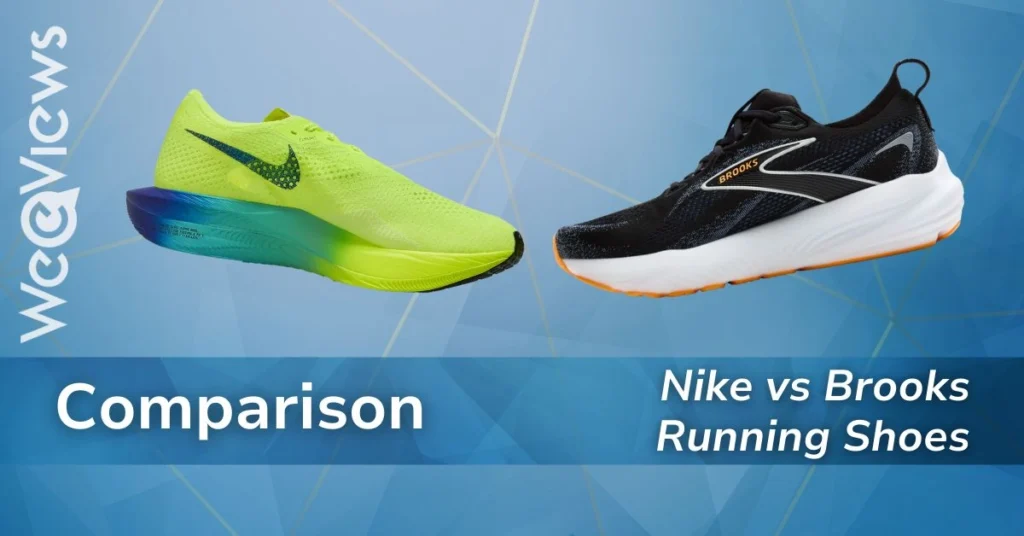
Image Source: WeeViews
Longevity plays a crucial role when investing in Brooks vs Nike footwear, affecting both performance and value over hundreds of miles.
Midsole Longevity: EVA vs ReactX Foam
Both brands recommend replacing running shoes after 300 to 500 miles, except for Nike’s VaporFly which lasts only 200-300 miles [7].
The material difference is significant—Nike’s React midsole maintains cushioning longer than Brooks’ EVA-based DNA Loft, which gradually loses its bounce [2].
According to foam experts, premium foams like those in racing shoes typically lose their “magic” within 150-250km but continue performing adequately for training [20].
Outsole Wear Patterns and Grip
Brooks Ghost features soft blown rubber on the forefoot with harder carbon rubber heels [2].
Conversely, Nike Pegasus uses thicker, harder rubber throughout, offering superior longevity [2].
Wear patterns vary based on foot strike, weight, pronation, and running surface [3].
Generally, softer rubbers provide better grip but wear faster—a classic durability-traction tradeoff [3].
Price Comparison: $120–$165 Range
Brooks shoes typically cost between $110-$150, whereas Nike’s range starts slightly higher at $120-$180 [1].
Premium models like Nike’s Vapor Fly exceed $200 [1].
Both brands offer their flagship models toward the higher end of their respective ranges [1].
? Which Offers Better Value Over Time
Overall, Brooks is often perceived as offering better value for comfort and durability [8].
Nonetheless, Nike justifies its premium pricing with advanced performance features [8].
For high-mileage runners, Brooks Ghost might outlast comparable Nike models [8].
Comparison Table
| Feature | Nike | Brooks |
| Brand Philosophy | Innovation and speed-focused design | Comfort-first and runner-centric engineering |
| Market Share | 28.1% of runners | 39.1% of runners |
| Target Audience | Elite/performance runners | Everyday runners |
| Flagship Model | Pegasus 41 | Ghost 17 |
| Weight (Men’s) | 10.4 oz | 10.1 oz |
| Stack Height | 37mm heel, 27mm forefoot | 36mm stack height |
| Heel Drop | 10mm | 10mm |
| Cushioning Technology | ReactX foam + Zoom Air units | DNA Loft v3 with nitrogen infusion |
| Fit Characteristics | Narrower toe box, runs small | Wider toe box, true to size |
| Width Options | Limited width options | Multiple options (Narrow to Extra Wide) |
| Sizing Recommendation | Size up by half size | True to size |
| Price Range | $120-$180 | $110-$150 |
| Recommended Lifespan | 300-500 miles (200-300 for VaporFly) | 300-500 miles |
| Best Use Case | Speed work, tempo runs | Long runs, daily training |
Conclusion
After looking at the differences between these running giants, you’ll need to pick between Brooks and Nike based on what you want from your running shoes. Brooks is the top dog for everyday runners, with a 39.1% market share compared to Nike’s 28.1%.
But this doesn’t mean it’s the best choice for everyone.
This comparison shows how these brands have very different approaches.
Nike is all about new ideas and making shoes for speed, using stuff like ReactX foam and Zoom Air units.
Brooks, on the other hand, puts comfort first and designs shoes with runners in mind, using things like their DNA Loft cushioning.
These different ways of thinking have a big impact on how their main shoes—the Ghost and Pegasus—feel when you’re out on the road.
When it comes to fit, Brooks gives a roomier feel with its wider toe box and several width choices making their shoes great for runners with broader feet or those needing extra space.
On the flip side, Nike tends to be more snug often needing a half-size up for the best comfort.
This difference in fit alone could be the deciding factor for many runners.
As for performance, each brand shines in different situations.
Nike’s Pegasus has a firm, bouncy ride that’s perfect for fast-paced runs and speed training.
Brooks’ Ghost offers a softer more padded experience that’s better for long runs and recovery days.
Both brands have special models for trail running and racing, but they take different approaches to stability, cushioning, and protection.
When it comes to durability, Brooks offers better value to everyday runners, as their shoes maintain consistent performance throughout their lifespan.
Nike’s higher price point is justified by its cutting-edge technologies, which benefit runners focused on performance.
Both brands have earned their place in the running community.
Your choice should match your foot shape running goals, and personal likes.
If comfort, stability, and a wider fit are your priorities, you should give Brooks a close look.
But if you want responsive performance innovative technology, and a sleeker look, Nike might suit you better.
No matter which you pick, both brands keep pushing the limits in running shoe design, which helps runners at all levels.
Key Takeaways
Here’s what you need to know to pick between Nike and Brooks running shoes based on your needs and how you run:
• Brooks rules the everyday runner market with a 39.1% share compared to Nike’s 28.1%. They put comfort first in their designs, while Nike focuses on speed and pushing performance limits.
• The fit is quite different between the two: Nike shoes tend to be narrow and small (you might want to go up half a size), but Brooks shoes fit true to size with more room in the toe area and come in different widths.
• How they perform depends on what you use them for: Nike Pegasus is great for faster runs thanks to its firmer ReactX foam, while Brooks Ghost gives you more cushioning for long runs and recovery.
• Brooks gives you more bang for your buck at $110-$150 compared to Nike’s $120-$180 range. Both brands’ top models last about 300-500 miles.
• Go for Brooks if you have wide feet, want comfort, or do regular training. Pick Nike if you’re after snappy performance, speed training, or cutting-edge racing tech.
In the end, your choice depends on your foot shape running aims, and whether you care more about comfort (Brooks) or high-tech performance (Nike).
Both brands make great shoes that have won over serious runners around the world.
FAQs
Q1. Which brand is better for everyday runners, Nike or Brooks? Brooks has more popularity among everyday runners, with a 39.1% market share compared to Nike’s 28.1%.
Brooks puts emphasis on comfort and designs that cater to runners making their shoes a solid pick for daily training and long runs.
Q2. How do Nike and Brooks differ in terms of fit? Nike shoes have a narrow and small fit often needing a half-size increase.
Brooks provides a wider toe box and several width choices fitting as expected. This makes Brooks a preferable option for runners with wider feet or those who need extra space.
Q3. What sets the Nike Pegasus apart from the Brooks Ghost? The Nike Pegasus contains ReactX foam and Zoom Air units giving a stiffer snappier feel that works well for tempo runs.
The Brooks Ghost uses DNA Loft v3 cushioning delivering a plusher more padded experience that fits better with long runs and recovery days.
Q4. How do Nike and Brooks stack up in cost and longevity? Brooks shoes cost between $110 and $150, while Nike’s prices start a bit higher at $120 to $180.
Both companies suggest getting new shoes after 300-500 miles, but many see Brooks as giving better bang for your buck in comfort and toughness for regular runners.
Q5. Which brand should I pick if I care about speed work and performance?
If you want to focus on speed work and performance, Nike might be your best bet.
Their shoes often have cutting-edge tech made for top runners, like the carbon fiber plates in their race shoes.
But if you’re more interested in comfort and stability, Brooks would be a better fit.
References
[1] – https://runtothefinish.com/nike-vs-brooks-running-shoes/
[2] – https://www.runningshoesguru.com/comparison/nike-pegasus-vs-brooks-ghost/
[3] – https://runrepeat.com/guides/insights-into-road-and-trail-running-shoe-outsoles
5] – https://runtothefinish.com/nike-pegasus-vs-brooks-ghost/
[6] – https://findmyfootwear.com/nike-pegasus-41-review-is-there-life-in-the-old-peg/
[7] – https://marathonhandbook.com/nike-vs-brooks/
[8] – https://www.weeviews.com/shoe-comparisons/nike-vs-brooks-running-shoes-2025
[11] – https://support.brooksrunning.com/hc/en-us/articles/360016013931-How-do-I-know-which-width-to-choose
[12] – https://www.nike.com/a/best-shoes-for-narrow-feet
[16] – https://www.doctorsofrunning.com/2025/05/brooks-glycerin-22-review-2025.html
[17] – https://www.solereview.com/nike-vomero-18-review/
[18] – https://www.irunfar.com/best-trail-running-shoes
[19] – https://believeintherun.com/shoe-reviews/nike-pegasus-trail-5-review/
[20] – https://runrepeat.com/guides/running-shoe-foams-guide


